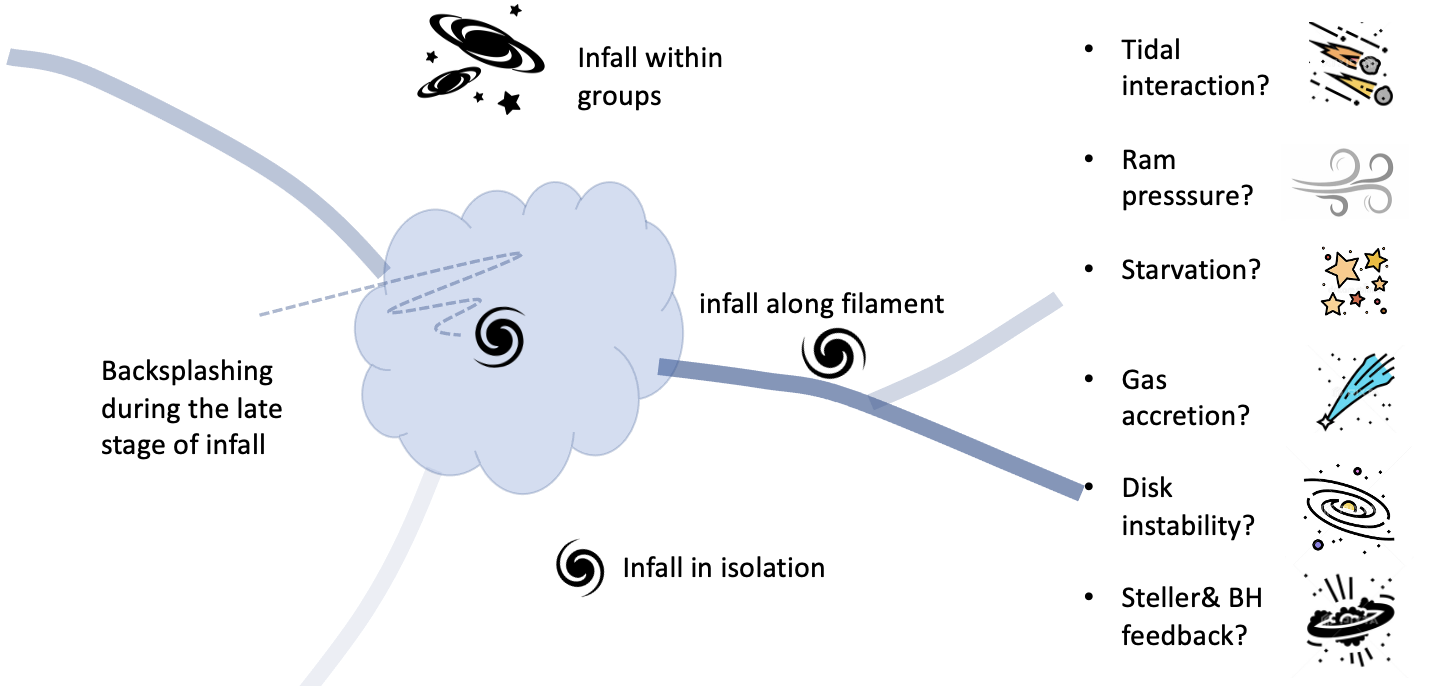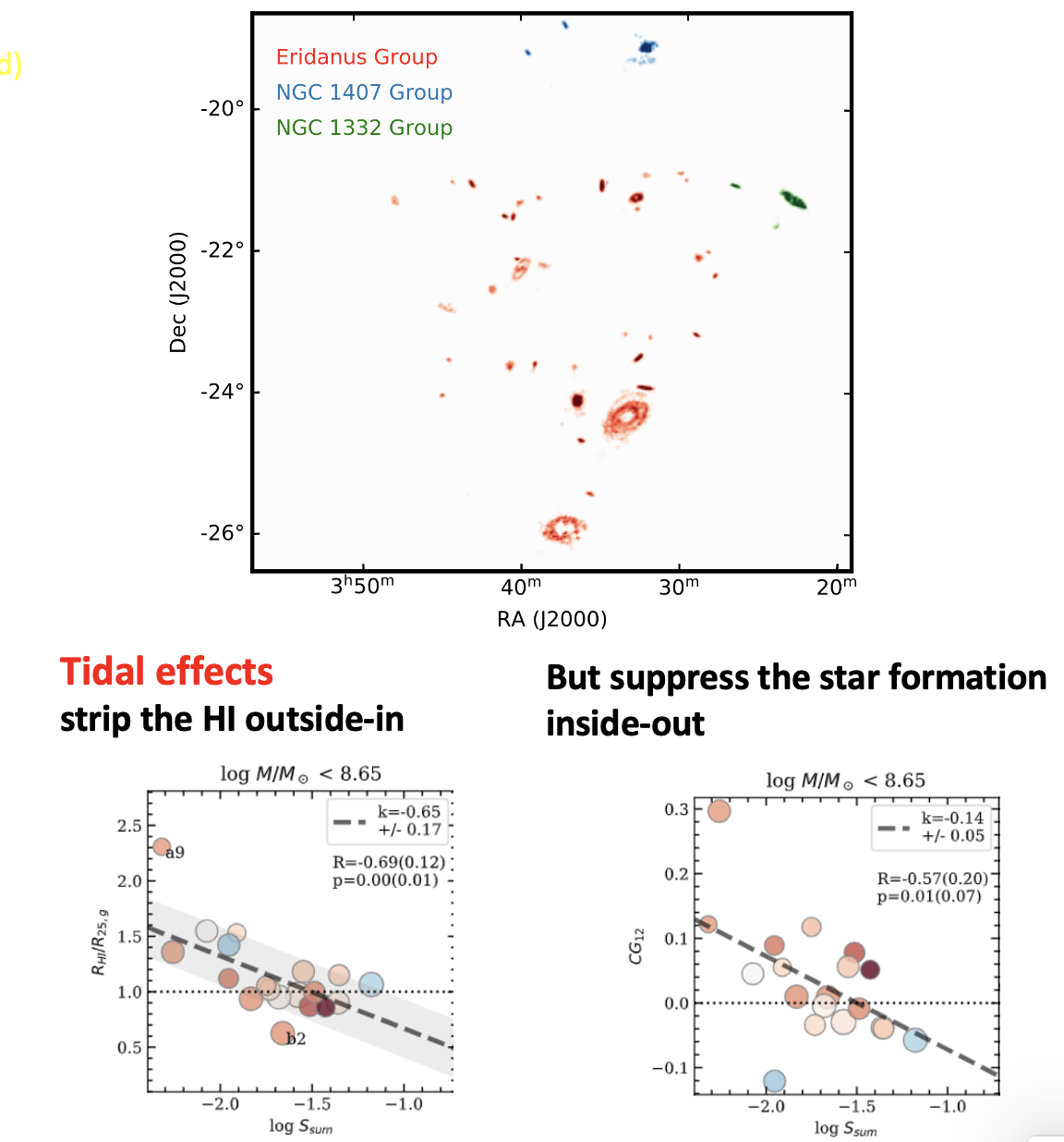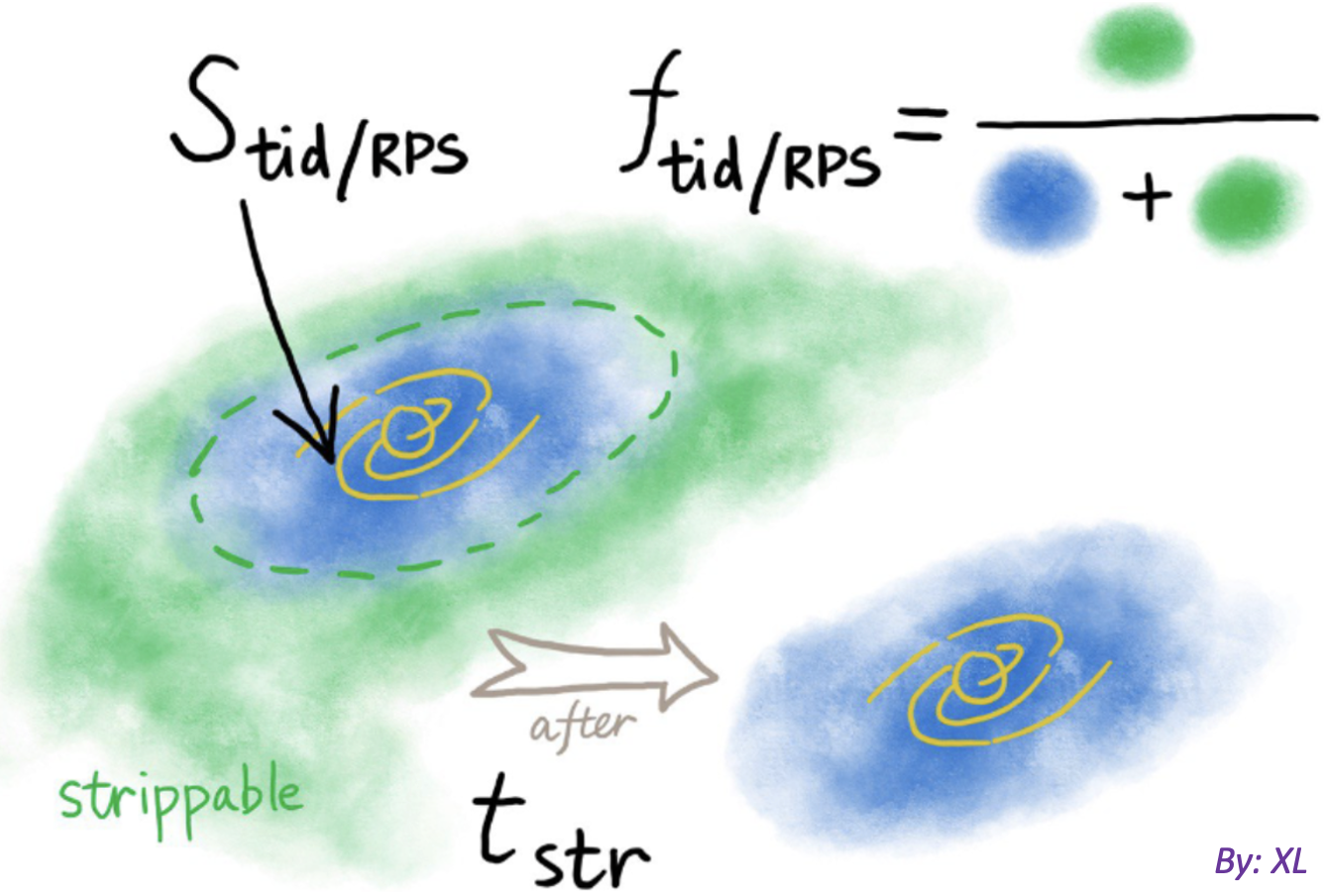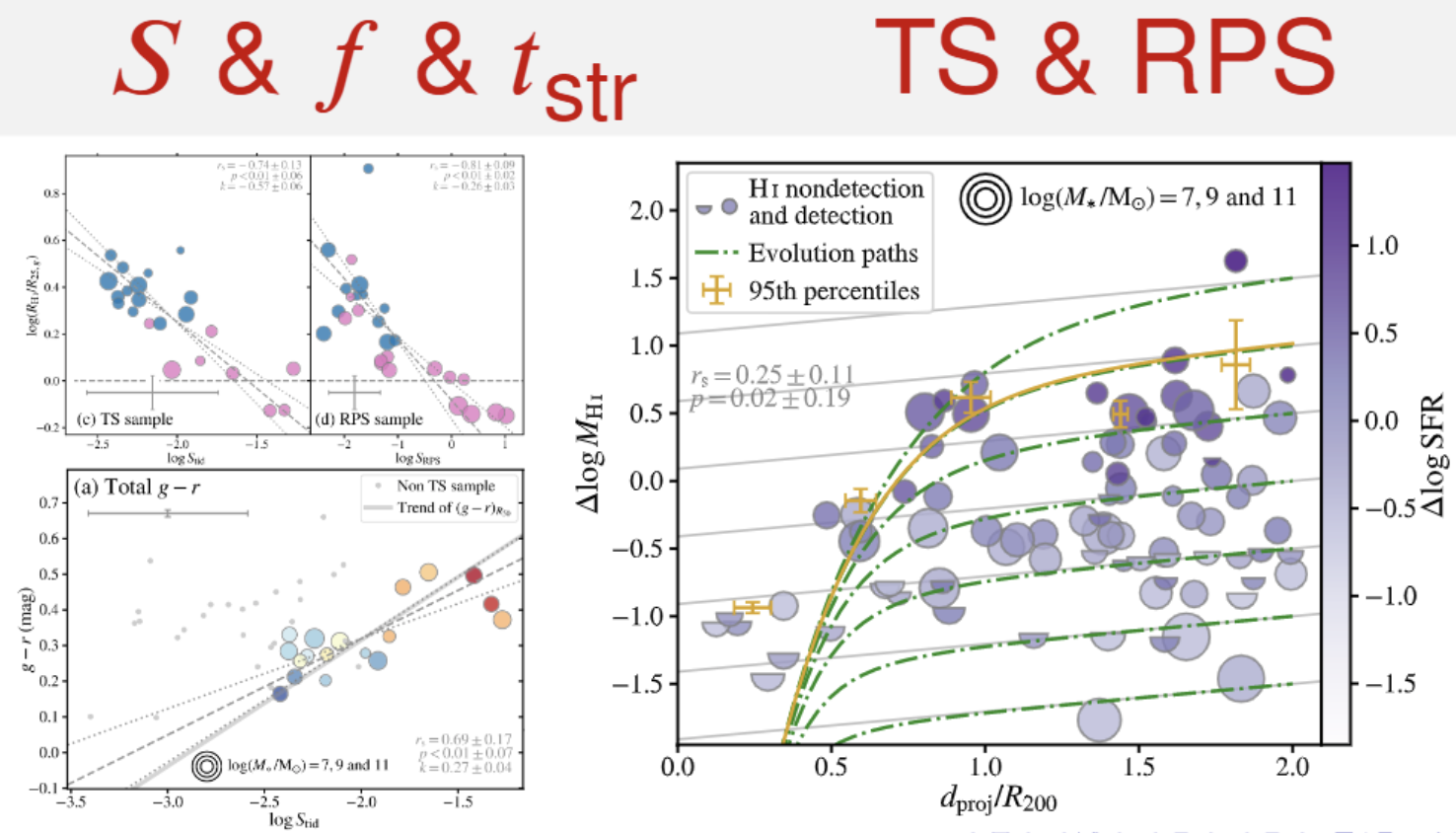The environmental processes
The ram pressure stripping, tidal interaction, strangulation, evaporation, etc.

Galaxies evolve strongly driven by internal physical processes, but also unavoidably affected by environmental effects. In certain circumstances, the external environment can dominantly determine the fate of a galaxy. Beyond those extreme circumstances, the diversity of environments still points to different evolutionary paths taken by galaxies. It is interesting to see how the nearby Coma cluster (sketch above) provides an excellent lab with samples of different local and large-scale environments, and in combination with galactic internal effects, points to complexities in galaxy evolution. We introduce our study of different environmetal mechanisms below.
Environmental effects in extreme environments
Diversity of RPS in the Hydra cluster
 This work is the first time that a massive cluster is homogeneously mapped in HI across a volume that extends far beyond the cluster region and with a sub-galactic scale resolution. It quantifies the instantaneous loss rate of HI in a galactic disk due to ram-pressure stripping from the hot intra-cluster gas where the HI disk is traveling through. They also quantify the level of ram-pressure and derive the mass of the strippable HI which is not sufficiently anchored to the disk by gravity against the ram pressure. They find that around 2/3 of the detected galaxies within 1.2 times the cluster radius may be under ram-pressure stripping (RPS), but the level of ram-pressure and thus the instantaneous HI loss rate differ widely among them. As a result, for at least half of the HI rich, infalling galaxies, ram-pressure stripping may accompany them for a long way after their infall: it may start in a galaxy at a cluster centric distance beyond the cluster radius, but only significantly deplete the whole HI disk when the galaxy gets close to the pericenter. These results highlight the potentially important role of weak ram-pressure stripping in shrinking the gas reservoir of star formation during satellite galactic evolution.
This work is the first time that a massive cluster is homogeneously mapped in HI across a volume that extends far beyond the cluster region and with a sub-galactic scale resolution. It quantifies the instantaneous loss rate of HI in a galactic disk due to ram-pressure stripping from the hot intra-cluster gas where the HI disk is traveling through. They also quantify the level of ram-pressure and derive the mass of the strippable HI which is not sufficiently anchored to the disk by gravity against the ram pressure. They find that around 2/3 of the detected galaxies within 1.2 times the cluster radius may be under ram-pressure stripping (RPS), but the level of ram-pressure and thus the instantaneous HI loss rate differ widely among them. As a result, for at least half of the HI rich, infalling galaxies, ram-pressure stripping may accompany them for a long way after their infall: it may start in a galaxy at a cluster centric distance beyond the cluster radius, but only significantly deplete the whole HI disk when the galaxy gets close to the pericenter. These results highlight the potentially important role of weak ram-pressure stripping in shrinking the gas reservoir of star formation during satellite galactic evolution.
Tidal effects on low-mass galaxies of the Eridaunus super-group
 This paper (also see For & Wang et al. 2021) uses the pre-pilot survey data of WALLABY of the Eridanus supergroup. The Eridanus supergroup is a unique environment in the local universe, as it is a major merger system of 3 groups. As a result, the local galaxy density is significantly enhanced, making Eridanus a perfect lab to study the tidal effects. We focus on the low-mass galaxies, which have stellar mass below 1.e9 Msun, which are more likely vulnerable victims of environmental effects. They also have not been as much studied as more massive galaxies in the SDSS era. More massive gas rich galaxies like the Milky Way tend to have red cores and blue outer disks, but these low-mass galaxies when unperturbed tend to have blue cores and red outer disks.
We find that, under stronger tidal stripping (TS), the color gradients in these low-mass galaxies tend to turn over and show red cores; meanwhile their HI disks become smaller. Thus, the tidal effects tend to quench these low-mass galaxies inside-out while strip their HI disks outside-in.
This paper (also see For & Wang et al. 2021) uses the pre-pilot survey data of WALLABY of the Eridanus supergroup. The Eridanus supergroup is a unique environment in the local universe, as it is a major merger system of 3 groups. As a result, the local galaxy density is significantly enhanced, making Eridanus a perfect lab to study the tidal effects. We focus on the low-mass galaxies, which have stellar mass below 1.e9 Msun, which are more likely vulnerable victims of environmental effects. They also have not been as much studied as more massive galaxies in the SDSS era. More massive gas rich galaxies like the Milky Way tend to have red cores and blue outer disks, but these low-mass galaxies when unperturbed tend to have blue cores and red outer disks.
We find that, under stronger tidal stripping (TS), the color gradients in these low-mass galaxies tend to turn over and show red cores; meanwhile their HI disks become smaller. Thus, the tidal effects tend to quench these low-mass galaxies inside-out while strip their HI disks outside-in.
Co-existent environmental effects in groups
Quantifying the strength, strippable gas fraction, and stripping time-scale
 After we successfully quantifying the (fraction of strippable gas due to) RPS in Hydra and (strength on the optical disk of) TS in Eridanus, we turn to less extreme environment where these two effects co-exist. It has been very hard to separate the two effects for general group galaxies. In order to do so, we now quantify the fraction of strippable gas, and the strength of perturbation upon optical disks due to each of the two effects. We also derive a new parameter, the time-scale of stripping.
After we successfully quantifying the (fraction of strippable gas due to) RPS in Hydra and (strength on the optical disk of) TS in Eridanus, we turn to less extreme environment where these two effects co-exist. It has been very hard to separate the two effects for general group galaxies. In order to do so, we now quantify the fraction of strippable gas, and the strength of perturbation upon optical disks due to each of the two effects. We also derive a new parameter, the time-scale of stripping.
 With these new parameters, we can separate the satellites of NGC 4636 group into RPS and TS dominated subsets. In each of the subsets, the HI disk to optical disk size ratio decreases as a function of the relevant effect strength (S); in the TS subset, the satellites further reddens with stronger TS strength. When galaxies from the other subset is mixed, all these correlations weakens. These results suggests the success of the method in disentangling the TS and RPS effects. Taking the larger of the two types of strippable fraction of HI, we obtain the instantaneous strippable HI fraction due to both effects. Further combining with the decreasing rate of galactic HI mass with projected distance to the group center, we derive the stripping timescale. This timescale, drops from several Gyrs at beyong the virial radius, to several tens of Myrs near the group center.
The details of these analysis and results can be found in this work
With these new parameters, we can separate the satellites of NGC 4636 group into RPS and TS dominated subsets. In each of the subsets, the HI disk to optical disk size ratio decreases as a function of the relevant effect strength (S); in the TS subset, the satellites further reddens with stronger TS strength. When galaxies from the other subset is mixed, all these correlations weakens. These results suggests the success of the method in disentangling the TS and RPS effects. Taking the larger of the two types of strippable fraction of HI, we obtain the instantaneous strippable HI fraction due to both effects. Further combining with the decreasing rate of galactic HI mass with projected distance to the group center, we derive the stripping timescale. This timescale, drops from several Gyrs at beyong the virial radius, to several tens of Myrs near the group center.
The details of these analysis and results can be found in this work
The census of ALFALFA and ROSAT detected group population
 This study was precursor of the study on the RPS effects in the Hydra cluster.
With the most complete overlap between the blind surveys in the HI (ALFALFA) and in the X-ray (ROSAT), we found that the weak ram pressure stripping, which only strips the outer region of HI disks, is affecting more than half of the HI-rich galaxies in X-ray bright groups and clusters out to large cluster-centric radius. Because the galaxies are HI-rich, they are likely infalling for the first time and being actively processed by the current environment, naturally seperated from the old cluster/group members which were there from a long time ago and have finished the processing of any enviornmental effects. Because the RPS affected population systematically extends beyond the virial radius of the cluster/group, the processing and pre-processing of the cluster/group do not have a physically clear separation. Because the weak RPS is affecting a large fraction of HI-rich galaxies, and is only stripping the outer disks of HI, it offers an alternative explanation for the slow quenching of SFR in satellite galaxies infalling into massive groups/clusters.
This study was precursor of the study on the RPS effects in the Hydra cluster.
With the most complete overlap between the blind surveys in the HI (ALFALFA) and in the X-ray (ROSAT), we found that the weak ram pressure stripping, which only strips the outer region of HI disks, is affecting more than half of the HI-rich galaxies in X-ray bright groups and clusters out to large cluster-centric radius. Because the galaxies are HI-rich, they are likely infalling for the first time and being actively processed by the current environment, naturally seperated from the old cluster/group members which were there from a long time ago and have finished the processing of any enviornmental effects. Because the RPS affected population systematically extends beyond the virial radius of the cluster/group, the processing and pre-processing of the cluster/group do not have a physically clear separation. Because the weak RPS is affecting a large fraction of HI-rich galaxies, and is only stripping the outer disks of HI, it offers an alternative explanation for the slow quenching of SFR in satellite galaxies infalling into massive groups/clusters.